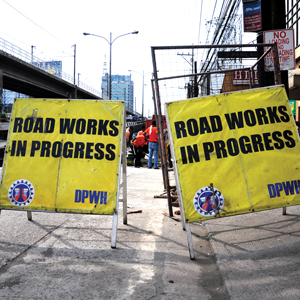If you are living in Metro Manila or in other urban areas of the Philippines, one thing you will notice is how the streets can immediately fill up with various vehicles during rush hours and even during night time. Rush hour traffic is a common sight for Filipinos.
While in the countryside where life is quite laid back, the observance of road safety is taken for granted. The highways are littered with improperly parked vehicles and makeshift stalls. We hear of reports of buses and other vehicles involved in deadly accidents so often that most of us do not get concerned or alarmed anymore. Reports on deadly road accidents become daily news feeds.
Our roads and highways are populated by big and small buses, old and new cars, locally made jeepneys, tricycles and pedicabs, with motorcycles zigzagging through narrow and unpaved lanes in the countryside and trains suddenly appearing from nowhere.
Along with the various causes of traffic on the streets, accidents and other unfortunate events can also happen, which can cause delay in the already crowded streets in the country.
Contributing to road safety is the lack of or poor urban planning of our cities and municipalities. Heart and Vascular system diseases are still the country’s top leading causes of death but being killed on our roads while walking or jogging increases the statistics.
According to Metro Manila Development Authority (MMDA), there were 77,110 road accidents in Metro Manila in 2011, with 7,656 accidents recorded in December. These resulted in 6,029 incidents of damage to property, 1,581 nonfatal injuries and 46 fatalities.
These road accidents claim lives. Based on statistics from the Philippine National Police-Highway Patrol Group (PNP-HPG), more than 1,500 persons died from vehicular accidents last year. Each month, the media reports various accidents around the country.
On May 14, eleven people were killed when a jeepney fell off a 150-meter deep ravine in Bontoc, Mountain Province. According to reports, the driver stopped his vehicle for a passenger to get off. He stopped in a steep incline, forcing the passengers seated on the roof to panic and jump off when the jeepney started to tilt towards the ravine.
On April 10, a Singapore-based Filipina nurse was killed when the ambulance she was riding was hit by a speeding pickup in Cebu City.
On March 26, a 51-year-old school directress and her daughter were killed after their car was rammed by a Philippine National Railways (PNR) train in a dark railroad crossing in Barangay Halang, Calamba, Laguna.
On February 24, three people were killed when the driver of an Isuzu Forward truck lost control of the brake, hitting three tricycles, two motorcycles and a dump truck in Rosales, Pangasinan.
On January 12, a wayward dump truck claimed the lives of 5 people, including an 11-year-old boy, and injured 13 others in a freak accident in Taytay, Rizal.
This spate of fatal road accidents begs the question, “How safe is it on the roads of the Philippines?”
PH Ranks 70th in Road Safety
Around the world, someone gets killed or seriously hurt on the road every 6 seconds—that translates to about 1.3 million road deaths each year. Often, the victims are the young, the poor, and the vulnerable.
In the Global Status Report on Road Safety 2009 published by the World Health Organization, the Philippines was ranked 70th out of a total 178 countries.
Traffic deaths in the Philippines were pegged at a rate of 20 people per 100,000 population. The country recorded 1,185 traffic deaths for year 2009. Neighboring ASEAN countries Thailand and Laos are behind the Philippines at ranks 73 and 79, with deaths per 100,000 population at 19.6 and 18.3 respectively.
The status report also reveals that 90 percent of the world’s road fatalities happen in low-income and middle-income countries, and such countries only amount to 48 percent of registered vehicles around the world. Among the fatalities, common are pedestrians, users of two-wheeled vehicles like bicycles or motorcycles. The WHO also predicts that road traffic injuries will rise in the ranks of leading causes of deaths worldwide.
Nationwide Statistics
In the Philippines, vehicular accidents occur on a daily basis and vary in severity. In unfortunate cases, road accidents lead to fatalities. If the numbers stated above were daunting, even more alarming are the statistics culled from all over the country.
In 2011, there were approximately more than 15,200 road accidents across the country as documented by the Philippine National Police – Highway Patrol Group (PNP-HPG).This was an estimate as there were a total of 14,795 road accidents from January to November 2011. There were also 1,399 individuals killed and 5,700 more injured due to road accidents in the said year. And 90.17 percent of the total deaths due to road accidents happened in the National Capital Region (NCR) according to PNP-HPG reports.
Using previous years’ statistics, road accidents cases are becoming a significant threat in society. In 2006, 15,064 traffic accidents, approximately 41 incidences a day, were reported. In 2010, 14,487 cases or approximately 39 accidents were reported per day. One of the years with the highest count for road accidents was 2003 where 16,425 accidents resulted in an estimate of 45 accidents per day.
Metro Manila Statistics
Metro Manila is bustling at the seams and it isn’t a wonder that most road accidents occur in it. The public roads of the metropolis are narrow. It has no sidewalks, and if there are, they are occupied by ambulant vendors, or turned into extensions of houses, and private parking areas.
The Metro Manila Accident Reporting and Analysis System (MMARAS) keeps track of the number of accidents that transpire in the area. This task is being manned by the Road Safety Unit (RSU) of the MMDA with the cooperation of the Traffic Enforcement Group under National Capital Regional Police Office (TEG-NCRPO) of the PNP.
To give you an idea on how risky it is to navigate the streets of Metro Manila as a driver, a passenger or a pedestrian, the MMARAS has revealed in its 2009 report that total vehicle accidents in NCR are 64,747. This high number accounts for all fatal and nonfatal vehicular accidents as well as damage to property.
Among the cases of vehicular accidents, motorcycles have the highest fatality rate amounting to 109 (29.46%) of the total count of fatal accidents. Motorcycles are followed by cars with 80 (21.62%) of the total count. As for nonfatal incidents, motorcycles still have the highest incidence rate with 6,677 (36.78%) and then followed again by cars with 4,543 (25.02%) of all reported incidences.
In the 2010 report of the MMARAS, accidents involving motorcycles are still significant. Total motorcycles involved in accidents for that year number at 17,096 according to the MMDA. Fatal accidents involving motorcycles amount to 33.75% of total accidents in Metro Manila. This is the highest accident rate among vehicles for year 2010.
Most accidents occur mainly on national roads and expressways. Accidents involving private vehicles numbered 5,344, followed by motorcycles with 2,788. Trucks and buses were ranked third and fourth, respectively. Along highways alone, the PNP-HPG has documented an increasing trend in road accidents from 6,978 cases in 2008, 10,526 in 2009, and up to 11,590 cases which is pegged at 62.3% of total number of road accidents recorded in year 2010.
The Question is ‘Why?’
Why the rash of road accidents? Road mishaps happen for a variety of reasons. Human factors, such as bad turns, overloading, and drunk driving, are among the reasons why accidents occur. Recent data show that 1,310 accidents occurred due to mechanical defects of the vehicles while 1,072 were blamed on road conditions.
A survey conducted last year seems to concur with such findings. The survey revealed that the major factors that contribute to road mishaps can be classified under human error. Sixty-four percent of those surveyed pointed to vehicle malfunction due to neglect as the cause of accidents; 44 percent cited overspeeding; 23 percent mentioned overloading; and 22 percent said violation of traffic rules.
Road accidents are products of a vicious cycle. These unfortunate incidents happen when we fail to do our share in ensuring the roads we travel along are safe. When we violate traffic rules, when we fail to keep our vehicles in good running condition, or when we unknowingly do the wrong thing, like making a bad turn—these factors can lead to accidents, and sadly, maybe even death.
Some accidents even happen because of selfish behavior. When drivers are way too sleepy to drive, or when they are intoxicated, or sick.
But not everything can be blamed on the man behind the wheel.
Among the other causes of road accidents are bad roads, and lack of traffic and warning signs, and poor weather conditions. The Philippines is noted for bad roads, either due to poor design or corrupt construction projects, poor maintenance, or lack of political leadership.
The numbers from the DOTC, MMDA and PNP do not indicate statistics blaming road condition as culprit. This is understandable because these agencies do not have enough traffic accident investigators competent enough to determine if road conditions are factors to accidents. Ironically, our highways are full of “Accident Prone Area” signs and having safer roads is one of the five pillars of road safety.
Other pillars are Safer Vehicles, Safer Road Users, Improved Road Safety management, and Post-Crash Care, which force the collaboration of road users, designers, private and government entities.
One tangible and readable effort to attain the goals of the five pillars is the publication of manuals on seat-belt and helmet design and use, drinking and driving, speed, and road safety and data systems management.
What Must Be Done?
Frequent road accidents result to deaths but people seem not to care. Sure, we mourn the loss of lives after a major vehicular accident, but after the outrage has died down, indifference takes over.
Many carry on with the same old disregard for traffic and road safety rules. Many still beat the red light; many still go over the speed limit. Old habits die hard.
In May 2011, Veteran journalist Lourdes ‘Chit’ Estella Simbulan died after a passenger bus crashed onto a taxi she was riding near the UP Technohub in Diliman, Quezon City. Her death shoved Commonwealth Avenue, the infamous Killer Highway, on the spotlight again and has raised the issue of road safety once more.
Accidents still happen around the area, as they do in all other places in the Philippines. But nothing concrete has come off the outcry except for louder voices coming from the DOTC itself and road safety advocates.
To commemorate the first death anniversary of Chit that coincided with the first year of DARS or Decade of Action for Road Safety, DOTC launched a dedicated website on road safety. The website, www.dotcdars.com, is linked to several social networking sites like Facebook and Twitter, and to the United Nations and World Health Organization websites.
These are laudable actions as other road safety advocates refer to the website as rich reference for materials for training and awareness campaigns. Almost all Public Utility Vehicles drivers do not have Facebook or Twitter accounts or access to computers. Actions must be concrete in terms of traffic enforcement that starts with traffic enforcers themselves and cascaded to all sectors of society. After all, road safety is everyone’s concern.










2 responses to “Rocky Road Safety in the Philippines”
😛
Those DPWH “Road Works in Progress” banners are such a SCAM.
It is but one scam among many, designed to give the impression actual work is being done. Why is it Yellow and not Orange? Why does it need the department’s seal on it, shouldn’t that be a given? Why doesn’t it give information as to how long a stretch said Roads Works extend? Why do they look different depending on which jurisdiction you are in? Why are there no Traffic Redirection barrels and cones BEHIND the banners and going AROUND the Work Area itself?
The answer, of course, is that the manufacture of the banners was but another scam designed to give a kickback to some project official while some un-certified “banner maker” fashioned those things at the lowest bidder.
Let’s take my favorite example, the United States, where anyone who’s lived there for years can tell you this: Road Works Signage and Banners all over the Union all LOOK THE SAME, they’re consistent, and there are no surprises. Whether they’re Federal or State or City projects, we don’t need to be told who’s banners they are.
Even driving unwisely-half-asleep I never got into any accidents because all those devices are highly-visible, and do not disappear below sight of your hood because they’re of sufficient height to drive beside; unlike Manila’s small traffic cones which are considered suitable only for Temporary Traffic Control for, say, Concert Venue Parking Lots in the States, at best.
https://www DOT osha DOT gov/doc/highway_workzones/mutcd/6f_typesofdevices.html
http://mutcd DOT fhwa DOT dot DOT gov/services/publications/fhwaop02084/
The seeds of the DPWH were planted as the BPW during the Commonwealth Era. Why haven’t they kept pace with their American peers and former mentors as this simple task of Traffic Management during Road Works?